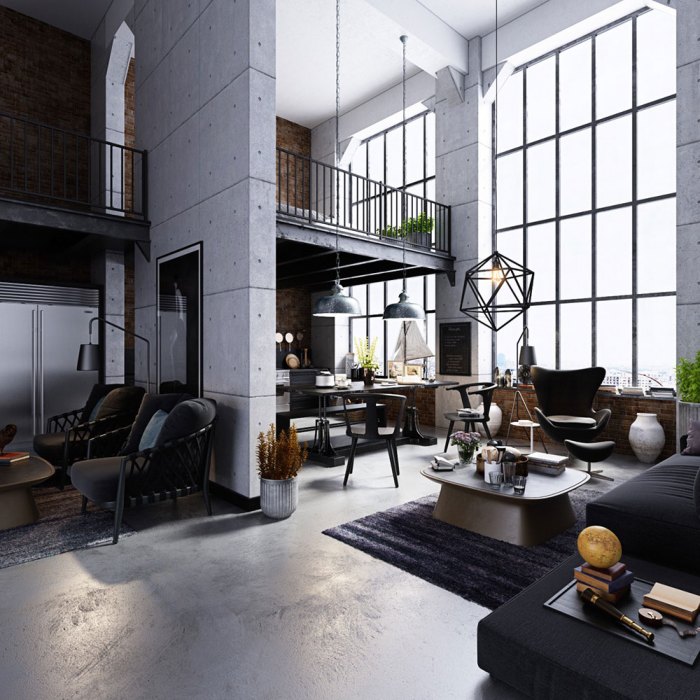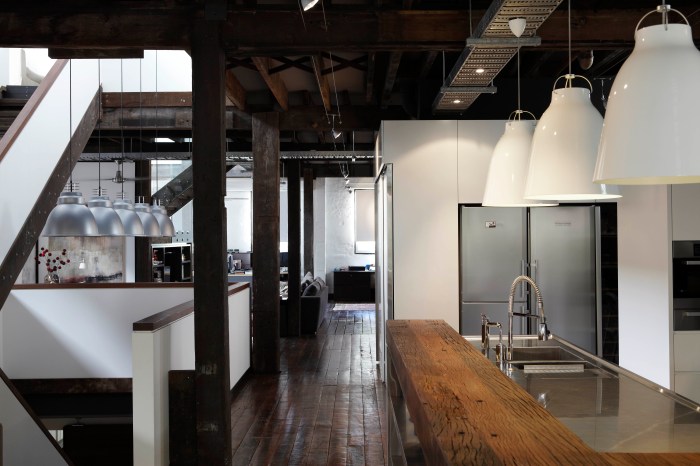Diving into the world of modern industrial interior design, this introduction sets the stage for a captivating exploration of the key elements and design principles that define this aesthetic.
Detailing the use of materials, color palettes, and furniture choices, this overview provides a comprehensive look at the unique blend of raw and refined elements that characterize modern industrial design.
Overview of Modern Industrial Interior Design
Industrial interior design is characterized by a raw and unfinished look that combines exposed brick, metal, and wood elements. This style often incorporates utilitarian objects, neutral colors, and a sense of minimalism.
Key Features of Modern Industrial Interior Design
- Exposed structural elements such as pipes, ducts, and beams
- Raw and unfinished textures like distressed wood and metal
- Utilitarian objects repurposed as decor, such as factory lights and metal shelving
- Open floor plans with high ceilings and large windows
Materials in Modern Industrial Interior Design
- Raw materials like steel, iron, and concrete
- Reclaimed wood for furniture and accent pieces
- Industrial metals such as copper, brass, and aluminum
- Concrete or brick walls for an urban feel
Color Palettes in Modern Industrial Interior Design
Industrial interior design often features a neutral color palette with bold accents. Common colors include:
- Neutral tones like gray, black, white, and brown
- Accents of bold colors like deep red, navy blue, or forest green
- Metallic finishes like silver, gold, or copper for added industrial flair
Furniture and Decor Elements
Industrial furniture and decor elements play a crucial role in creating the distinctive look of modern industrial interior design. These elements are characterized by their raw and rugged appearance, often incorporating materials such as metal, wood, and leather to create a unique aesthetic.
Characteristics of Furniture in Modern Industrial Interior Design
Industrial furniture typically features clean lines, minimalistic designs, and a focus on functionality. Pieces are often made from reclaimed materials or have a distressed finish to add to the industrial feel. Common furniture pieces include metal chairs, wooden tables, and leather sofas, all contributing to the overall industrial vibe of the space.
Incorporating Industrial Lighting Fixtures
When it comes to industrial lighting fixtures, exposed bulbs, metal pendant lights, and vintage-inspired lamps are popular choices. These fixtures not only provide adequate lighting but also serve as statement pieces that enhance the industrial look of the space. Incorporating these fixtures strategically can help create a warm and inviting atmosphere while maintaining the industrial aesthetic.
Role of Exposed Brick Walls and Concrete Floors
Exposed brick walls and concrete floors are key elements in modern industrial interior design. They add texture, depth, and a sense of history to the space, creating a visually interesting backdrop for the furniture and decor. The rough surfaces of brick and concrete contribute to the industrial feel while also providing a contrast to the sleek furniture pieces, resulting in a harmonious blend of modern and rustic elements.
Creating Texture and Contrast

When it comes to modern industrial interior design, creating texture and contrast is key to achieving a dynamic and visually appealing space. By incorporating different textures and contrasting elements, you can add depth and interest to the overall design.
Adding Texture
One way to add texture to modern industrial interiors is by incorporating materials like exposed brick, concrete, metal, and reclaimed wood. These raw and rugged materials not only add a sense of authenticity to the space but also create a tactile experience for anyone in the room.
- Utilize textiles such as leather, faux fur, or plush rugs to introduce softer textures that provide a cozy and inviting feel amidst the industrial elements.
- Consider incorporating accent walls with textured wallpaper or paint techniques like faux finish or distressed effects to bring depth and character to the space.
- Introduce elements like woven baskets, knitted throws, or decorative pillows to add layers of texture and warmth to the overall design.
Incorporating Contrast
Contrast is essential in modern industrial interior design as it helps highlight different elements and create a visually stimulating environment. By juxtaposing rough textures with smooth surfaces or dark tones with light colors, you can achieve a balanced and harmonious look.
- Pair industrial elements like metal light fixtures or exposed pipes with softer elements like velvet upholstery or silk curtains to create a striking contrast in the space.
- Mix and match different finishes such as matte and glossy surfaces, or rough and polished textures to add visual interest and depth to the design.
- Use contrasting colors like black and white, or dark charcoal with light gray to create a bold and dramatic impact while maintaining a cohesive overall look.
Balancing Raw Industrial Elements with Soft Textures
To achieve a cohesive look in modern industrial interiors, it's important to balance the raw industrial elements with softer textures effectively. This ensures that the space feels inviting and comfortable while still retaining its industrial charm.
- Combine industrial materials like steel or concrete with softer textiles such as velvet, linen, or wool to create a harmonious blend of textures that offer both visual interest and comfort.
- Layer different textures throughout the space, from rough exposed brick walls to plush area rugs, to create a sense of depth and dimension that adds warmth to the overall design.
- Introduce natural elements like plants or wooden furniture to soften the industrial aesthetic and bring a touch of warmth and organic texture to the space.
Designing Functional Spaces
When it comes to modern industrial interior design, optimizing space is crucial to ensure functionality and efficiency within a given area. Integrating storage solutions and creating a seamless flow between different spaces are key aspects of designing functional spaces in an industrial setting.
Optimizing Space in Industrial Design
Industrial spaces often have high ceilings and large open areas, which can be challenging to work with when trying to create functional spaces. To optimize space in modern industrial design, consider using multi-functional furniture pieces that serve dual purposes, such as storage ottomans or convertible tables.
Additionally, utilizing vertical space with wall-mounted shelves or storage units can help maximize storage without taking up valuable floor space.
Integration of Storage Solutions
Storage is essential in any functional space, and in industrial interior design, incorporating storage solutions seamlessly into the overall design is key. Industrial-style shelving units, metal cabinets, and vintage storage trunks not only provide ample storage but also add to the overall industrial aesthetic of the space.
Consider using storage solutions that complement the design style while also serving a practical purpose.
Creating a Seamless Flow Between Areas
To create a seamless flow between different areas within an industrial space, consider using consistent design elements throughout, such as exposed brick walls, metal accents, and industrial lighting fixtures. Open floor plans and strategically placed furniture can help delineate different areas while maintaining a cohesive design aesthetic.
Additionally, incorporating elements like area rugs or room dividers can help define specific zones within a larger space while still maintaining a sense of continuity.
Final Wrap-Up

In conclusion, modern industrial interior design offers a harmonious fusion of industrial charm and contemporary style, creating spaces that are both functional and visually striking.
Top FAQs
What are the key features of modern industrial interior design?
The key features include exposed brick walls, concrete floors, metal fixtures, and a blend of raw and refined materials.
How do you balance raw industrial elements with softer textures in modern industrial design?
You can achieve balance by incorporating elements like plush rugs, warm textiles, and soft furnishings to offset the industrial elements.
What are common color palettes used in modern industrial interior design?
Neutral tones like grays, blacks, whites, and earthy tones are commonly used to create a sleek and industrial feel.
